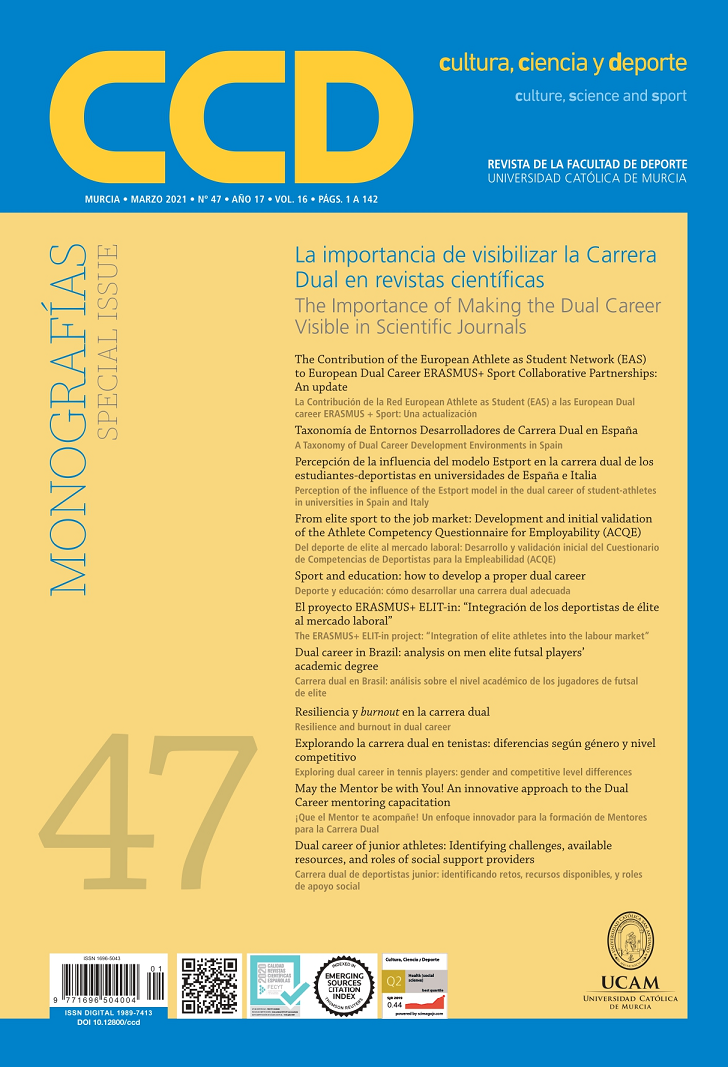Explorando la carrera dual en tenistas: diferencias según género y nivel competitivo (Exploring dual career in tennis players: gender and competitive level differences)
DOI:
https://doi.org/10.12800/ccd.v16i47.1697Palabras clave:
Deporte, élite, carrera dual, tenis, profesional (Sport, elite, dual career, tennis, professional)Resumen
Los objetivos del presente estudio fueron: i) describir la carrera dual de tenistas de la Comunidad de Madrid; ii) analizar si existen diferencias en dicha carrera en función del género, y iii) del nivel de competición. Se elaboró un cuestionario ad-hoc teniendo como referencia el cues-tionario de percepción de los estudiantes universitarios-deportistas de alto nivel sobre la carrera dual,
ESTPORT (Sánchez-Pato et al., 2016). La muestra estuvo formada por 60 tenistas (21.5± 2.8 años) residentes en la Comunidad de Madrid. De ellos, 55% eran hombres y un 45% eran mujeres. Entrenaban una media de 3.9 ± 1.3 días y 17.2 ± 6.2 horas a la semana. Los resultados confirman que superan cada curso académico en dos años aproximadamente, una falta de planificación de su futuro fuera de la carrera deportiva y una elevada identificación con el rol de deportista. Ellas tienen menos aspiraciones en su carrera tenística, quizás por el hecho que el circuito profesional de tenis femenino sea más modesto económicamente. En esa misma línea, al finalizar su carrera tenística las mujeres piensan dedicarse a trabajar en lo que estudien en ma-yor medida que los hombres. Los jugadores de nivel internacional tienen un alto compromiso con su carrera deportiva. Sus mayores
dificultades para su carrera dual no son en relación a la falta de flexibilidad horaria para desarrollar ambas carreras. Se plantean recomendaciones prácticas para los profesionales que trabajen con estos deportistas.
===
The aims of this study were: i) to describe the dual career in tennis players from the Madrid Region; ii) to analyze if there are differences regarding gender, and iii) competition level. An ad-hoc questionnaire
was developed taking as reference the perception questionnaire of high-level university students-athletes about the dual career, ESTPORT (Sánchez-Pato et al., 2016). The sample was comprised by 60 tennis players (21.5 ± 2.8 years) residents in the Madrid Region.
Fifty-five percent were men while forty-five percent were women. They trained an average of 3.9 ± 1.3 days and 17.2 ± 6.2 hours per week. Results confirm that each school year takes them about two years for passing it, a lack of planning a future out of the sport
career and a high identification as athletes. Regarding gender comparison, women has less expectations on their sport career. This perception could be due the lower prize money in the women’s circuit. Women planned to work in relation to the studies the aim to
finish. Regarding the competitive level, international level tennis players have a high commitment with the sport career. The main difficulties are not financial; they are the lack of flexibility at timetables to develop both careers. Practical insights for practitioners that work with tennis players are proposed.
Citas
AGM (s.f). AGM. https://www.agmeducation.com/
Aquilina, D. (2013). A study of the relationship between elite athletes' educational development and sporting performance. International Journal of the History of Sport, 30, 374-392. https://doi.org/10.1080/09523367.2013.765723
Allison, M.T., & Meyer, C.W. (1988). Career Problems and Retirement among Elite Athletes: The Female Tennis Professional. Sociology of Sport, 5, 212-222. https://doi.org/10.1123/ssj.5.3.212
Barriopedro, M., López de Subijana, C., & Muniesa., C. (2016). Perspectiva de género en la inserción laboral de los deportistas olímpicos españoles. Cuadernos de Psicología del deporte,16(1), 339-350. Recuperado a partir de https://revistas.um.es/cpd/article/view/254691
Barriopedro, M., de Subijana, C. L., & Muniesa, C. (2018). Insights into life after sport for Spanish Olympians: Gender and career path perspectives.
PloS one, 13(12). e0209433. https://doi.org/10.1371/journal.pone.0209433
Brewer, B. W., & Petitpas, A. J. (2017). Athletic identity foreclosure. Current opinion in psychology, 16, 118-122. https://doi.org/10.1016/j.copsyc.2017.05.004
Brown, C. J., Webb, T. L., Robinson, M. A., & Cotgreave, R. (2018). Athletes' experiences of social support during their transition out of elite sport: An interpretive phenomenological analysis. Psychology of Sport and Exercise, 36, 71-80. https://doi.org/10.1016/j.psychsport.2018.01.003
Chamorro, J. L., Sánchez-Oliva, D., & Pulido, J. J. (2019). The critical transition from junior to elite football: Resources and barriers. In Football Psychology (pp. 324-336). Routledge.
Chamorro J. L., Torregrossa M., Sánchez-Miguel P. A., Sánchez-Oliva D., & Amado D. (2015). Challenges in the transition to elite football: Coping resources in males and females. Revista Iberoamericana de Psicología del Ejercicio y el Deporte, 10(1), 113-119. Extraído de: https://www.riped-online.com/abstract/challenges-in-the-transition-to-elite-football-coping-resources-in-males-and-females-19085.html
Chamorro, J., L., Torregrossa, M., Sánchez-Oliva, D., García-Calvo, T. y León, B. (2016). Future achievements, passion and motivation in the transition from junior-to-senior sport in Spanish young elite soccer players. The Spanish Journal of Psychology, 19(e69), 1-12. https://doi.org/10.1017/sjp.2016.71
COE (s.f.). Oficina de Atención al Deportista. https://www.oad.es/oad/oad_home.nsf
Cohen J. (1988). Statistical power analysis for the behavioral sciences (2nd ed.). Lawrence Earlbaum Associates.
Comisión Europea. (2012). EU guidelines on dual careers of athletes. Extraído de: https://op.europa.eu/en/publication-detail/-/publication/3648359d-61c4-4132-b247-3438ee828450
Cosh, S., & Tully, P.J. (2014). “All I have to do is pass”. A discursive analysis of student athletes’ talk about prioritising sport to the detriment of education to overcome stressor encountered in combining elite sport and tertiary education. Psychology of Sport and Exercise, 15, 180-189. https://doi.org/10.1016/j.psychsport.2013.10.015
Côté, J., & Vierimaa, M. (2014). The developmental model of sport participation: 15 years after its first conceptualization. Science & Sports, 29, S63-S69. https://doi.org/10.1016/j.scispo.2014.08.133
Crespo, M., & Crespo, C. (2017). La carrera dual en el tenis: una alternativa necesaria para la formación completa del tenis. E-Coach - Revista Electrónica del Técnico de Tenis, 25(9), 7-14.
Ekengren, J., Stambulova, N., Johnson, U., & Carlsson, I. M. (2020). Exploring career experiences of Swedish professional handball players: Consolidating first-hand information into an empirical career model. International Journal of Sport and Exercise Psychology, 18(2), 156-175. https://doi.org/10.1080/1612197X.2018.1486872
Filipcic, A., Panjan, A., Reid, M., Crespo, M., & Sarabon, N. (2013). Tournament structure and success of players based on location in men’s professional tennis. Journal of sports science & medicine, 12(2), 354-361. Extraído de: https://www.ncbi.nlm.nih.gov/pmc/articles/PMC3761828/
Franck, A., & Stambulova, N. B. (2019). The junior to senior transition: a narrative analysis of the pathways of two Swedish athletes. Qualitative Research in Sport, Exercise and Health, 11(3), 284-298. https://doi.org/10.1080/2159676X.2018.1479979
Fraser-Thomas, J., Côté, J., & Deakin, J. (2008). Understanding dropout and prolonged engagement in adolescent competitive sport. Psychology of sport and exercise, 9(5), 645-662. https://doi.org/10.1016/j.psychsport.2007.08.003
Gallo-Salazar, C., Salinero, J. J., Sanz, D., Areces, F., & del Coso, J. (2015). Professional tennis is getting older: Age for the top 100 ranked tennis players. International Journal of Performance Analysis in Sport, 15(3), 873-883. https://doi.org/10.1080/24748668.2015.11868837
Gaston-Gayles, J. L. (2004). Examining academic and athletic motivation among student athletes at a division I university. Journal of College Student Development, 45(1), 75-8.
Kim, H. Y. (2017). Statistical notes for clinical researchers: chi-squared test and Fisher's exact test. Restorative dentistry & endodontics, 42(2), 152-155. https://doi.org/10.5395/rde.2017.42.2.152
Knights, S., Sherry, E., Ruddock-Hudson, M., & O’Halloran, P. (2019). The End of a Professional Sport Career: Ensuring a Positive Transition. Journal of Sport Management, 33(6), 518-529. https://doi.org/10.1123/jsm.2019-0023
Kristiansen, E. (2017). Walking the line: How young athletes balance academic studies and sport in international competition. Sport in Society, 20(1), 47-65. https://doi.org/10.1080/17430437.2015.1124563
Li, P., De Bosscher, V., & Weissensteiner, J. R. (2018). The journey to elite success: a thirty-year longitudinal study of the career trajectories of top professional tennis players. International Journal of Performance Analysis in Sport, 18(6), 961-972. https://doi.org/10.1080/24748668.2018.1534197
López de Subijana, C, Barriopedro, M, Conde, E., Sánchez, J, Ubago, E, & Gallardo, L. (2015). Análisis de las barreras percibidas por los deportistas de élite españoles para acceder a los estudios. Cuadernos de Psicología del Deporte, 15(1), 265-274. https://dx.doi.org/10.4321/S1578-84232015000100025
López de Subijana Hernández, C., Barriopedro, M., Muniesa, C. A., & Galocha. J.L. (2018). La retirada deportiva en deportes colectivos: comparativa profesionales y amateurs. SPORT TK-Revista EuroAmericana De Ciencias Del Deporte, 7(1), 41-46. https://doi.org/10.6018/321851
Martin, L., Fogarty, G., & Albion, M. (2014). Changes in athletic identity and life satisfaction of elite athletes as a function of retirement status. Journal of Applied Sport Psychology, 26, 96-110. https://doi.org/10.1080/10413200.2013.798371
Mateos, M., Torregrossa, M., & Cruz, J. (2010). Evaluation of a career assistance programme for elite athletes: satisfaction levels and exploration of career decision making and athletic-identity. Kinesiologia Slovenica, 16, 1-2, 30-43.
Mertens, D.M. (2005). Research and evaluation in education and psychology: Integrating diversity with quantitative, qualitative, and mixed methods (2nd ed.). Sage.
North, J., & Lavalee, D. (2004). An investigation of potential users of career transition services in the United Kingdom. Psychology of Sport and Exercise, 5 (1), 77-84. https://doi.org/10.1016/S1469-0292(02)00051-1
Pallarés, S., Azócar, F. Torregrossa, M., Selva, C., & Ramis, Y. (2011). Modelos de trayectoria deportiva en waterpolo y su implicación en la transición hacia una carrera profesional alternativa. Cultura, Ciencia y Deporte, 6, 93-10. http://dx.doi.org/10.12800/ccd.v6i17.36
PROAD, 2020. Programa de Atención al Deportista de Alto Nivel. https://proad.csd.gob.es/
Decreto 1835/1991, de 20 de diciembre, sobre Federaciones deportivas españolas.
Regüela, S. (2012). Programa Excel·lència i Transicions (ÈXITS): el projecte personal com a eina per afrontar les transicions de la carrera esportiva. Universitat Autonoma de Barcelona.
RFET (2019). El tenis x etapas. Extraído de: https://tenisxetapas.rfet.es/proyecto
RFET (2020). Condiciones de acceso a ayudas a tenistas de la Real Federación Española de Tenis. Extraído de: https://www.rfet.es/es/rfet-transparencia-documentos-economicos-becas.html
Reid, M., Morgan, S., Churchill, T., & Bane, M. K. (2014). Rankings in professional men’s tennis: A rich but underutilized source of information. Journal of Sports Sciences,32(10), 986-992. https://doi.org/10.1080/02640414.2013.876086
Reid, M., & Morris, C. (2013). Ranking benchmarks of top 100 players in men’s professional tennis. European Journal of Sport Science,13(4), 350-355. https://doi.org/10.1080/17461391.2011.608812
Ryan, C. (2015). Factors impacting carded athlete’s readiness for dual careers. Psychology of Sport and Exercise, 21, 91-97. https://doi.org/10.1016/j.psychsport.2015.04.008
Sánchez-Pato, A., Calderón, A., Arias-Estero, J.L., García-Roca, J.A., Bada, J., Meroño,L., Isidori, M., Brunton, J., Decelis, A., Koustelios, A., Mallia, O., Fazio, A., Radcliffe, J.,& Sedgwick, M. (2016). Design and validation of a questionnaire about the perceptions of dual career student-athletes (ESTPORT). Cultura_Ciencia_Deporte, 11(32), 127-147. http://dx.doi.org/10.12800/ccd.v11i32.713
Sorkkila, M., Aunola, K., Salmela-Aro, K., Tolvanen, A., & Ryba, T. V. (2018). The codevelopmental dynamic of sport and school burnout among student-athletes: The role of achievement goals. Scandinavian Journal of Medicine & Science in Sports, 28,1731-1742. https://doi.org/10.1111/sms.13073
Stambulova, N., Engström, C., Franck, A., Linnér, L., & Lindahl, K. (2015). Searching for an optimal balance: Dual career experiences of Swedish adolescent athletes. Psychology of Sport and Exercise, 21, 4-14. https://doi.org/10.1016/j.psychsport.2014.08.009.
Stambulova, N. B., Ryba, T. V., & Henriksen, K. (2020). Career development and transitions of athletes: the International Society of Sport Psychology Position Stand Revisited. International Journal of Sport and Exercise Psychology. https://doi.org/10.1080/1612197X.2020.1737836
Stambulova, N., Stephan, Y., & Jäphag, U. (2007). Athletic retirement: A cross-national comparison of elite French and Swedish athletes. Psychology of Sport and exercise, 8(1), 101-118. https://doi.org/10.1016/j.psychsport.2006.05.002
Stambulova, N., & Wylleman, P. (2014). Athletes' career development and transitions. En A. G. Papaioannou & D. Hackfort (Eds.), International perspectives on key issues in sport and exercise psychology. Routledge companion to sport and exercise psychology: Global perspectives and fundamental concepts (p. 605-620). Routledge/Taylor & Francis Group.
Stambulova, N., & Wylleman, P. (2019). Psychology of athletes' dual careers: A state-of-the-art critical review of the European discourse. Psychology of Sport and Exercise, 42, 74-88. https://doi.org/10.1016/j.psychsport.2018.11.013
Stephan, Y., & Brewer B.W. (2007). Perceived determinants of identification with the athlete role among elite competitors. Journal of Applied Sport Psychology, 19(1). 67-79. https://doi.org/10.1080/10413200600944090
TeamBepro (s.f.). https://www.teambepro.com/pagina/que-es-be-pro
Thomas, J. R., Nelson, J. K., & Silverman, S. J. (2015). Research methods in physical activity. Human Kinetics.
Torregrossa, M., Chamorro, J. M., & Ramis, Y. (2016). Transición de júnior a sénior y promoción de carreras duales en el deporte: una revisión interpretativa. Revista de Psicología Aplicada al Deporte y al Ejercicio Físico, 1(1), 1-11. https://doi.org/10.5093/rpadef2016a6
Torregrossa, M., Chamorro, J. L., Prato, L., & Ramis, Y. (en prensa). Grupos, Entornos y Carrera Deportiva. En García Calvo, T., Leo, F. M. y Cervelló, E. (Eds.), Dirección de grupos deportivos. Editorial Tirant lo Blanch.
Torregrossa, M., Pallarés, S., Chamorro, J. L., Ramis, Y., Latinjak, A., & Jordana, A. (2017). Career trajectories: the not always easy path to dual career. En BASES Conference 2017 – Programme and Abstracts, Journal of Sports Sciences (p. 106). https://doi.org/10.1080/02640414.2017.1378421
Torregrossa, M., Ramis, Y., Pallarés, S., Azócar, F. & Selva, C. (2015). Olympic athletes back to retirement: A qualitative longitudinal study. Psychology of Sport and Exercise,21, 50-56. https://doi.org/10.1016/j.psychsport.2015.03.003
Universidad de Navarra (s.f.). Programa Talento Deportivo. https://www.unav.edu/web/vida-universitaria/talento-deportivo1
UCAM, (s.f.). Servicio de deportes. http://www.ucamdeportes.com/servicio-de-deportes
Young, J., Pearce, A., Kane, R., & Pain, M.D. (2006). Leaving the professional tennis circuit: exploratory study of experiences and reactions from elite female athletes. British Journal of Sports Medicine, 40,477-483. http://dx.doi.org/10.1136/bjsm.2005.023341
Warriner, L. & Lavallee, D. (2008). The retirement experiences of elite female gymnasts: self-identity and the physical self. Journal of Applied Sport Psychology, 20(3), 301-317. https://doi.org/10.1080/10413200801998564
Willard, V. C., & Lavallee, D. (2016). Retirement experiences of elite ballet dancers: Impact of self-identity and social support. Sport, Exercise, and Performance Psychology, 5(3), 266-279. https://doi.org/10.1037/spy0000057
Wylleman, P., & Rosier, N. (2016). Holistic perspective on the development of elite athletes. En M. Raab, P. Wylleman, R. Seiler, A.-M. Elbe, & A. Hatzigeorgiadis (Eds.), Sport and exercise psychology research: From theory to practice (p. 269-288). Elsevier Academic Press.
Descargas
Publicado
Cómo citar
Número
Sección
Licencia
Los autores que publican en esta revista están de acuerdo con los siguientes términos:- Los autores conservan los derechos de autor y garantizan a la revista el derecho de ser la primera publicación del trabajo al igual que licenciado bajo una Creative Commons Attribution License que permite a otros compartir el trabajo con un reconocimiento de la autoría del trabajo y la publicación inicial en esta revista.

















